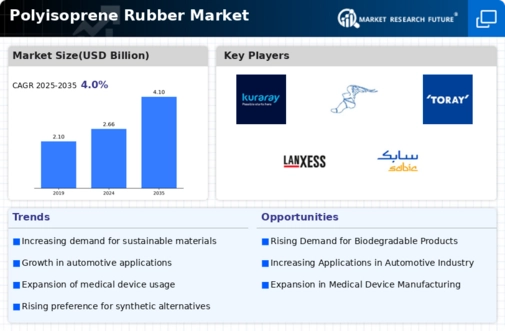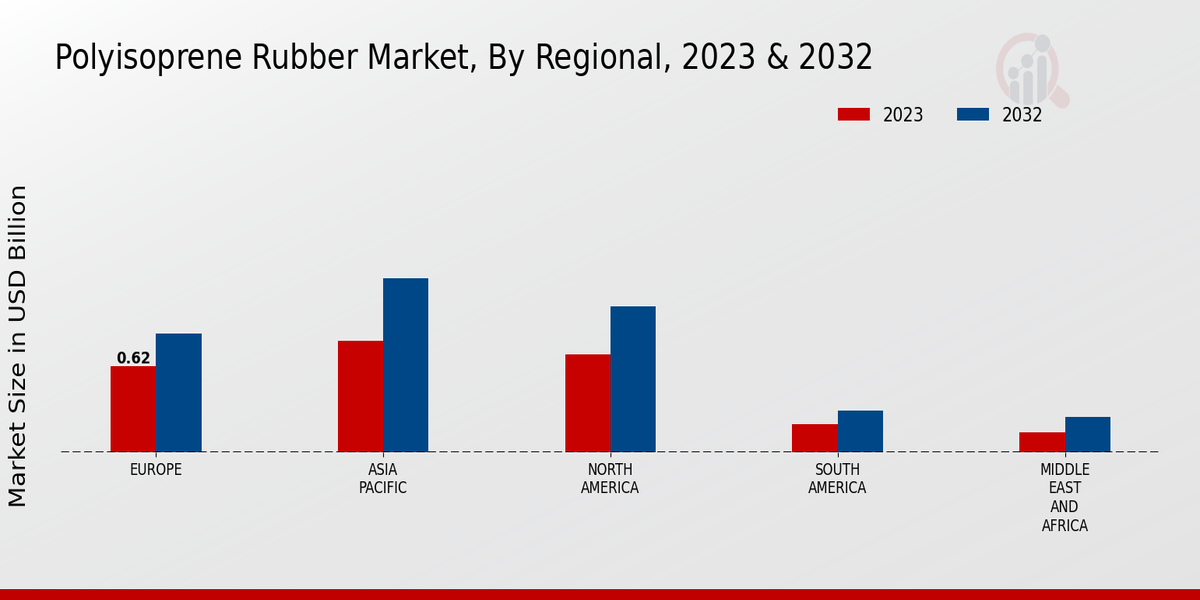Market Growth Projections
Growing Demand in Automotive Sector
The Global Polyisoprene Rubber Market Industry experiences a notable surge in demand from the automotive sector, driven by the increasing production of vehicles. Polyisoprene rubber is utilized in various automotive components, including tires and seals, due to its excellent elasticity and durability. As of 2024, the market is projected to reach 2.66 USD Billion, reflecting the automotive industry's recovery and growth. The shift towards electric vehicles further enhances the demand for high-performance materials, suggesting a robust future for polyisoprene rubber in this sector. This trend indicates a potential for sustained growth as the automotive industry evolves.
Expanding Footprint in Consumer Goods
The Global Polyisoprene Rubber Market Industry is expanding its footprint in consumer goods, particularly in the production of household items and personal care products. Polyisoprene's versatility allows it to be used in a variety of applications, including footwear, adhesives, and toys. As consumer preferences shift towards high-quality and durable products, the demand for polyisoprene rubber is likely to increase. This trend is indicative of a broader movement towards premium materials in consumer goods, suggesting that the market may continue to grow as manufacturers seek to meet these evolving consumer demands.
Rising Applications in Medical Devices
The Global Polyisoprene Rubber Market Industry benefits from the rising applications of polyisoprene in medical devices, particularly in the production of gloves and catheters. Polyisoprene's biocompatibility and flexibility make it an ideal material for healthcare applications. The increasing focus on hygiene and safety in medical environments has led to a heightened demand for polyisoprene products. As healthcare systems globally prioritize the use of high-quality materials, the market is expected to expand significantly. This trend may contribute to the overall growth of the market, with projections indicating a rise to 4.1 USD Billion by 2035, reflecting the increasing reliance on polyisoprene in medical applications.
Technological Advancements in Production
Technological advancements in the production of polyisoprene rubber are likely to drive the Global Polyisoprene Rubber Market Industry forward. Innovations in polymerization techniques and processing methods enhance the efficiency and quality of polyisoprene production. These advancements not only reduce production costs but also improve the material's properties, making it more appealing for various applications. As manufacturers adopt these technologies, the market is poised for growth, potentially achieving a compound annual growth rate of 4.01% from 2025 to 2035. This growth trajectory suggests that the industry is adapting to meet the evolving demands of end-users across multiple sectors.
Increasing Demand for Sustainable Materials
The Global Polyisoprene Rubber Market Industry is witnessing a shift towards sustainable materials, driven by environmental concerns and regulatory pressures. Polyisoprene, being a synthetic rubber derived from renewable resources, aligns with the growing preference for eco-friendly alternatives. Industries are increasingly seeking materials that minimize environmental impact, and polyisoprene's sustainable attributes position it favorably in this context. As consumers and manufacturers alike prioritize sustainability, the demand for polyisoprene rubber is expected to rise. This trend may further bolster the market, contributing to its projected growth as industries adapt to more sustainable practices.







